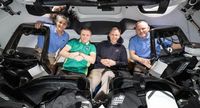Two NASA astronauts, Suni Williams and Butch Wilmore, have successfully returned to Earth following an extraordinary nine-month mission aboard the International Space Station (ISS). Initially launched in June 2024, the duo aimed for what was supposed to be an eight-day stay in orbit. However, technical failures with their Boeing Starliner spacecraft transformed their brief visit into a significant ordeal.
On March 18, 2025, the pair boarded a SpaceX Crew Dragon capsule named 'Freedom' at 1:05 AM ET, completing a 17-hour journey back to Earth. As they undocked from the ISS, they bid farewell to seven fellow astronauts who remained aboard. Their capsule eventually splashed down smoothly off the coast of Tallahassee, Florida, around 5:57 PM local time (9:57 PM GMT), greeted by applause at the recovery operations center.
The unexpected duration of Williams and Wilmore's stay at the ISS stemmed from critical issues affecting the Starliner’s propulsion system. Technical difficulties included problems with propulsion systems and helium leaks, which ultimately delayed their planned return. This led to NASA deciding to rescue the astronauts via a SpaceX capsule instead of their original vessel. The successful landing of 'Freedom' is a testament to the collaborative efforts between government and private space enterprises.
During their extended time in space, Williams and Wilmore completed various scientific experiments, pushing the boundaries of human endurance and research capabilities. Such extended missions, while critical for advancing space exploration, also pose health risks including potential bone and muscle loss, vision impairments, and changes in cardiovascular function. NASA has implemented comprehensive medical protocols to address these challenges, ensuring the astronauts' safe reintegration into Earth's gravity.
Reflecting on the mission, astronaut Nick Hague, who commanded the Crew-9 mission aboard the capsule, remarked, “What a ride! I see a capsule full of smiles from ear to ear.” This sentiment captures the profound relief and triumph felt by everyone involved in the mission’s successful conclusion.
The astronauts will undergo routine medical evaluations upon their return to the Johnson Space Center in Houston before reuniting with their families. The duration of this mission—approximately 286 days—while significantly longer than the standard six-month ISS stay, still fell short of Frank Rubio's record of 371 consecutive days in space, achieved between 2022 and 2023 for different reasons.
Williams, a veteran of three spaceflights, has accumulated an impressive 608 days in space, securing her position as one of the most experienced astronauts in the United States, second only to Peggy Whitson. The challenges the crew faced, however, were not without precedent; historically, astronauts have encountered various hurdles during spaceflight, which makes each successful mission a significant milestone.
As discussions commence regarding the future of human space exploration, the collaboration provided between agencies such as NASA and private entities like SpaceX exemplifies a unified direction for ambitious forthcoming missions. The positive outcome of this particular expedition also serves to validate the ongoing efforts to develop reliable transportation systems for astronauts venturing into orbit and beyond.
The entire mission underscores the importance of resilience and adaptability within the realm of space travel. Challenges faced during the mission not only test the capabilities of astronauts but also facilitate advancements in technology and operational strategies necessary for future explorations.
While the stars may have aligned for Williams and Wilmore at their dramatic landing, scientists and engineers will be analyzing data from this mission meticulously. Lessons learned will contribute to the safety and efficiency of future missions, ultimately paving the way for long-term human presence on Mars and beyond.
In conclusion, the return of Suni Williams and Butch Wilmore marks another success chapter in human space exploration. Their journey encapsulates human ingenuity and determination, showcasing the vast potential of collaboration between government bodies and private industries in the realm of astronautics.




